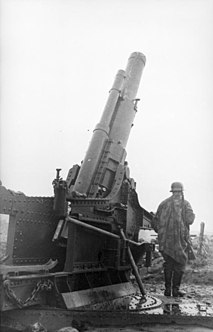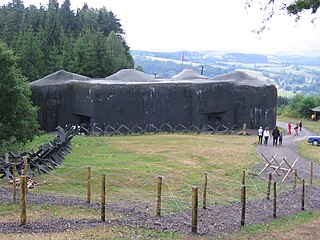
The National Redoubt was a strategic defensive belt of fortifications built in Belgium. The National redoubt was the infrastructural cornerstone of Belgian defensive strategy from 1890–1940.

The 3,7cm ÚV vz. 38, manufacturer's designation Škoda A7, was a 37 mm tank gun designed by the Skoda Works in Czechoslovakia prior to World War II.

The Škoda 30.5 cm Mörser M.11 was a siege howitzer produced by Škoda Works and used by the Austro-Hungarian Army during World War I and by Nazi Germany in World War II.

The 10 cm M. 14 Feldhaubitze was a dual-purpose field and mountain gun used by Austria-Hungary during World War I. Between the wars it was used by Austria, Italy, and Poland. During World War II it served as the standard medium howitzer of the Royal Italian Army with the designation Obice da 100/17 modello 14 and after 1943 captured weapons were used by Nazi Germany's Wehrmacht under the designations 10 cm leFH 14(ö), 10 cm leFH 315(i) and 10 cm leFH 315(j). After World War II an updated howitzer remained in service with the Italian Army until 1975.

The 8 cm kanon vz. 30 was a Czech field gun used in the Second World War. Guns captured after the German invasion of Czechoslovakia in March 1939 were taken into Wehrmacht service as the 8 cm FK 30(t). It was used by a variety of German units during World War II, including I./SS-Artillerie-Abteilung 3 between 1939 and 1940.
The 24 cm houfnice vz.39 was a Czechoslovak-designed siege howitzer used in the Second World War. It was kept in production after the German occupation of Czechoslovakia in March 1939 and eighteen were delivered to the Germans. It was only used by the Army's Artillery Regiment 814 and entered service shortly before the Battle of France in 1940. The regiment participated Operation Barbarossa and in the Sieges of Sevastopol and Leningrad.

The 24 cm Mörser M 98 was a heavy siege howitzer used by Austria-Hungary during World War I. It was designed to attack modern fortifications, but its short range and ineffective ammunition led to the development of the more deservedly famous 30.5 cm Mörser M 11 and M 16.

The 15 cm schwere Feldhaubitze M 14 was a heavy howitzer which served with Austria-Hungary during World War I.

The 38 cm Belagerungshaubitze M 16 was a super-heavy siege howitzer used by Austria-Hungary during World War I.

The 42 cm L/15 Küstenhaubitze M. 14 was a superheavy siege howitzer used by Austria-Hungary during World War I and by Nazi Germany during World War II.

The 21 cm Mörser M. 16 was a heavy howitzer used by Austria-Hungary during World War I and it is completely different weapon than the German 21 cm Mörser 16. Skoda began design in 1915 for a wheeled howitzer that could be towed in a single load by a tractor. The first prototype wasn't satisfactory as it was too heavy and traversing was difficult due to the very high limber bar pressure. A second howitzer was delivered in mid-1917 that broke down into two loads for transport. This, at least, cured the traversing problem of the first weapon, as reported by the test battery assigned to the 11th Army. In the meantime, however, a third prototype had been ordered as the M. 18 with a carriage based on that of the 30.5 cm Mörser M. 16 that would allow for full traverse at the price of more time needed to emplace the firing platform. It broke down into three loads for transport. No M. 18s were delivered by the end of the war, although Skoda built some modified versions as the M. 18/19 for the newly independent Republic of Czechoslovakia where they were known as the 21 cm mozdir vz. 18. After the Occupation of Czechoslovakia in 1939 the Germans adopted them under the names of 21 cm Mörser 18/19(t) or kurze 21 cm Mörser(t) and used at least 15 on coast-defense duties in Norway.
Skoda houfnice vz 14 and Skoda houfnice vz 14/19 were 100 mm (3.93-inch) field howitzers made in Czechoslovakia by the Skoda works.

This article deals with the history of tanks employed by military forces in Czechoslovakia from the interwar period, and the more conventional tanks designed for the Czech Army before World War II, and the tanks that ended up as Panzers of the German Wehrmacht during World War II, or in the use of other countries who purchased them before the war began.

The 28 cm howitzer L/10 was a Japanese coastal and siege howitzer. It was developed by Armstrong before 1892 and saw service in the Russo-Japanese War during the siege of Port Arthur and the Second Sino-Japanese War.

The Škoda 220 mm howitzer was a siege howitzer design which served with Germany, Poland, and Yugoslavia before and during World War II.
The 8 cm kanon vz. 28 was a Czech field gun used during World War II.
The 10 cm houfnice vz. 28 was a Czech howitzer used in limited numbers by the Yugoslav Army during World War II. The Yugoslavians ordered twenty houfnice vz. 28 guns which they referred to as the 100 mm M.28. Guns captured from Yugoslavia by the Germans were given the designation 10 cm leFH 317(j).


















